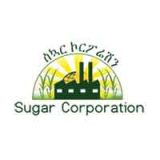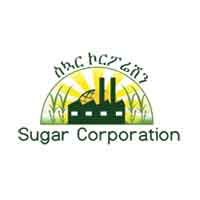This company has no active jobs
Company Information
- Total Jobs 0 Jobs
- Location Addis Ababa
About Us
Ethiopian Sugar Corporation
Mission
Creating modern technology and capable human resource so as to develop the nation’s potential to the sector produce sugar, sugar bi-products and co-products and take remarkable foreign market share and support the nation’s economy beyond satisfying domestic demand and ensuring the benefits of the public.
Vision
Ensuring sustainable growth, becoming one of the ten competitive sugar producing countries of the world in 2023.
Values
- Sustainable change and competitiveness;
- Virtuous work ethics;
- Productivity is crucial to our existence;
- Popularity is our typical feature;
- We never stop learning;
- We encourage creativity and best performance;
- Working in team spirit is our unique feature;
- Environment protection is fundamental to our development;
- Human resource Development is vital to our success.
Purposes of Establishment of Sugar Corporation According to Regulation No192/2010
- To grow sugarcane and other sugar yielding crops;
- To process and produce sugar, sugar products, sugar by-products and products of sugar by- products;
- To sell its products and by-products in the domestic and export markets;
- Undertaking of feasibility studies, design preparation, technology selection and negotiation, erection and commissioning of new sugar development and expansion projects;
- In cooperation with the relevant organs undertake studies and research in the field of sugar cane plantation and sugar production technologies and implement useful results there of;
- In cooperation with capable domestic enterprises, to cause the designing and fabrication of machineries and spare parts required by public sugar factories;
- To possess, in accordance with the law, and develop lands required for its operations;
- To encourage and support sugar cane out growers who are supplying their cane products to public Sugar factories;
- To cooperate with the concerned educational institutions in producing the required type, number and quality of trained manpower for the sugar industry;
- In line with directives and policy guidelines issued by the Ministry of Finance, to sell and pledge bonds and to negotiate and sign loan agreements with local and international financial sources;
- To engage in any other related activities necessary for the attainment of its purposes.
Ethiopian Sugar Industry Profile
It was at Wonji in 1951 some 110 km east of the capital Addis Ababa that modern sugar industry started in Ethiopia as a share company established by foreign private investors & Ethiopian government. By then the Netherland’s H.V.A. Company had entered into the sector as a foreign share holder. When the factory started production in 1954 its initial production was 140 tons of sugar a day. At the start, the share company had five thousand hectares of land for its sugarcane cultivation. As its location is one of the most suitable areas of the world to the sector it opened a door to Wonji Candy Factory to come forward.
Then, followed Shoa Sugar Factory in 1962 with 170 tons of sugar production capacity a day. The two factories known by the name Wonji Shoa Sugar Factories /which later on administered as one factory/ altogether had the capacity of producing 75,000 tons of sugar per annum till 2012 i.e. prior to the completion of the new Wonji Shoa Sugar Factory. Serving for more than half a century and getting obsolete, these two Wonji and Shoa sugar factories were closed in 2012 and 2013 respectively. Replacing these pioneer factories, the new and modern factory had started production in 2013.
The second factory, Metehara Sugar Factory is established as a share company between same Netherlands Company and the then Ethiopian government in 1965 and started production in 1969 at a location known as Merti some 200 km from Addis Ababa. Currently, the factory with a total 10,235 hectares of sugarcane cultivation land has a capacity of producing more than 130 thousand tons sugar and 12.5 million liters ethanol a year on average.
Five years after the establishment of Metehara Sugar Factory i.e. in 1974 following the dawn fall of the emperor’s regime all sugar factories were made to be administered under the ownership of the government according to notice number 58/1978 of the then Ministry of Industry and started operating under the then Ethiopian Sugar Corporation. The corporation had also been made to administer the Addis Ketema and Asmara Candy Factories together with the above mentioned three sugar factories.
Meanwhile, in relation with sugar development, Fincha valley is found to be suitable and sustainable for sugar development as per studies conducted in 1974. Based on this extensive study was underwent in 1978 by the British Bookers Agricultural International Limited, for the establishment of the country`s third sugar factory – Fincha Sugar Factory.
Construction of the factory which was delayed by finance shortage started in 1988 and cane planting in 1991. It was completed eight years later and inaugurated by the former FDRE president H.E Negaso Gidada (Dr.) and began regular production in1998.
The gap between the establishment and commencement of production of the factory is mainly occurred due to the political change the nation had undergone.
Its finance sources were African Development Bank and Development Fund, Governments of Australia and Spain as well as domestic banks of the nation.
Its initial sugar production was 50 thousand tons per annum. More modern than the former factories, the factory’s construction job including its ethanol plant was executed by American company known as F.C. Shefer and Associates and Netherland’s company called Dewetto International while many domestic construction companies had also played their part in the process.
Later in 1992 the Corporation which had administered the three sugar factories was dissolved by stature after 14 years of service. All the above factories were reestablished as separate public enterprises. Metehara and Wonji Shoa Sugar Factories by regulation number 88/93, and Fincha Sugar Factory by regulation number 199/1994 have become independent public enterprises.
Following this the Ethiopian Sugar Industry Support Center came into existence in 1998 to provide support to the factories. The center was established as a share company of the Development Bank of Ethiopia, Ethiopian Insurance Corporation and the three sugar factories. Years later, Ethiopian Sugar Development Agency was established by proclamation number 504/2006 in its stead. The Agency had given support the factories in project development, research, training and marketing.
In 2006 Tendaho Sugar Factory was established by Regulation Number 122/2006 as a fourth project in the country. Construction of the factory with the capacity of crushing 13 thousand tons of sugarcane per day has started production in 2014. The first phase, using sugarcane produced on 25,000 hectares of land.
Sugar Corporation
The present Sugar Corporation with a vision of executing sugar development activities at a large scale came into existence on October, 2010 by the Council of Ministers Regulation No.192/2010. It is operating under a board of directors. Currently the Corporation is accountable to Public Enterprises’ Property and Administration Agency as dictated on proclamation number 1097/2018.
Ever since its establishment in October 2010 Sugar Corporation has benefited communities of the areas in which the development is going on. It has made irrigation, potable water, roads, schools, health posts and other social service institutions available for the local community. It is also expanding land covered with sugarcane, increases the number of sugar factories and creates job opportunities. However; it is possible to witness that it has yet to do a lot in increasing housing construction, and sugar co-products supply.
To fulfill its major goals and tackle problems faced the Corporation is implementing change management and other series of tasks. Along with this capacity building trainings are going on locally and abroad.
Sugar Industry Sub Sector
Sugar development sector is one among other huge projects which enables industry take a leading role in the nation’s economy. Ethiopia has huge human as well as natural resources which enable the nation to broaden this export oriented manufacturing industry sector and its productivity.
The nation has suitable climate, 1.4 Million hectares wide and proved irrigable agricultural land as well as abundant resource of water and ample labor resource. The government has given higher attention to the sector and it is working for further development of it.
Productivity
The country is rich with resources like suitable climate, fertile land and abundant water supply which are favorable for sugarcane development. Hence, it is possible to cultivate 162 tons of sugarcane per hectare on average in 15 months. In relation to the productivity it is possible to produce 10.8 tons of sugarcane in Ethiopia per month and when compared against the global sugarcane production potential it outstrips the global production per hectare in 2.3 tons.
Cognizant of this fact, the FDRE government has started broadening the sugar development sector which had been limited to Wonji Shoa and Metehara Sugar Factories for more than half a century to Oromiya, Afar, Amhara, Tigray and Southern Nations, Nationalities and Peoples Regional States since 2010.
Based on this at two sugar factories are under construction with crushing capacities 12 thousand tons sugarcane per day using sugarcane to be planted on36thousand 277 hectares of land at Tana Beles Sugar Development Project in Amhara Region.
On the other hand, there are four sugar factories which use sugarcane developed on 100 thousand hectares land in South Omo, Bench Maji and Kaffa zones of Southern Nations, Nationalities and Peoples Region where Omo Kuraz Sugar Development Project is found.
The constructions of these factories are at different levels. Among these Omo Kuraz Sugar Factory Number Two and Three have started production, with each having crushing capacity of 12 thousand tons of sugarcane a day.
Whereas the other two factories with each having crushing capacity of 12 thousand and 24 thousand tons of sugarcane a day are under construction.
In the same way, construction of Welkayit Sugar Development Project in Tigray region, which will use sugarcane developed on 39 thousand 500 hectares of land and has the capacity to crush 24 thousand tons of sugarcane a day is advancing.
Commencing 10 huge sugar development projects which require high investment in the lowland areas of the country is challenging. However our motto is “we learn while working.” And, hence our sugar development projects in the areas which have no infra-structure before are becoming hopeful.
Though the successes so far are not as anticipated, it is possible to say thatthey foresee the bright future of the industry. We had only three sugar factories till 2014. But now we have eight operational factories while making the existing ones expanded.
Generally, from the new sugar factories Tendaho, Kessem, Arjo Diddessa, Omo Kuraz Number Two and Omo Kuraz Number Three`s construction is completed and the factories have started production.
Moreover, it has been possible to make the land covered with sugarcane to 102 thousand 741 hectares from 30 thousand 397 hectares in 2009. This is made possible by the efforts made in the past eight years. Similarly, the efforts made to increase irrigation infrastructure becomes fruitful. On the other hand, the effort made to benefit the local community from the development in the area is encouraging.
Community Services
- Hand in hand with the sugar development, Sugar Corporation working with Ministry of Water, Irrigation and Energy has built 255 social service institutions like schools, potable water supply, health institutions, mills and roads.
- Members of the local community are given priorities to be hired at the projects after training on tractor operation, building, carpentry and the like. This continues in the future.
- The local youth are organized in micro and small enterprises to take part in the development activities and generate income. This also continues now and in the future.
- Irrigated land is given for the local pastoralist community. The pastoralists now have begun producing crops like maize. In the future conditions are laid for them to be sugarcane out growers who sell the product to the sugar factory around. In order to make this possible they have got experiences from sugar cane out growers of Wonji Shoa Sugar Factory.
- From 2010 to 2017, Sugar Corporation has spent about 1.2 billion birr for the construction of social service institutions, infra-structure, compensation, vocational training and others to benefit the local community.
- In conclusion, ever since the development is started in 2010 more than 450 thousand citizens have got jobs on permanent, temporary and contractual basis.
Domestic Sugar Supply
Even though the nation`s sugar industry has scored more than half a century, it has failed to satisfy the domestic demand because of the following facts:
- Growing demand of sugar of the society in relation to the fast economic development the country is registering;
- Growing of population and
- Due to Increasing number of industries which use sugar as an input, the sugar demand and supply has been incompatible.
The current sugar supply is about 650 thousand to 700 thousand tons of sugar per annum. Of these 325 thousand to 400 thousand tons of sugar is produced in the country. To fill in this gap about 200 thousand to 300 thousand tons of sugar is imported annually by the government spending high amount of foreign currency. Though only 7 kilo grams is being supplied, the current sugar consumption per individual in Ethiopia is more than 10 kilo grams a year.
As stated earlier the government spends higher foreign exchange and distribute sugar to balance the demand and supply. As importing sugar is not a long lasting solution, the sugar industry sub sector is given due attention ever since the inception of the first growth and transformation plan along with other manufacturing industry sectors.
Ethiopia is extensively expanding sugar development projects in low land areas carrying out “Sugar Revolution” so as to:
- Narrow the gap between demand and supply of sugar;
- Improve the lives of citizens by creating vast job opportunities;
- Ensure the benefits of citizens of the development areas and
- Earn foreign currency by exporting the product.


